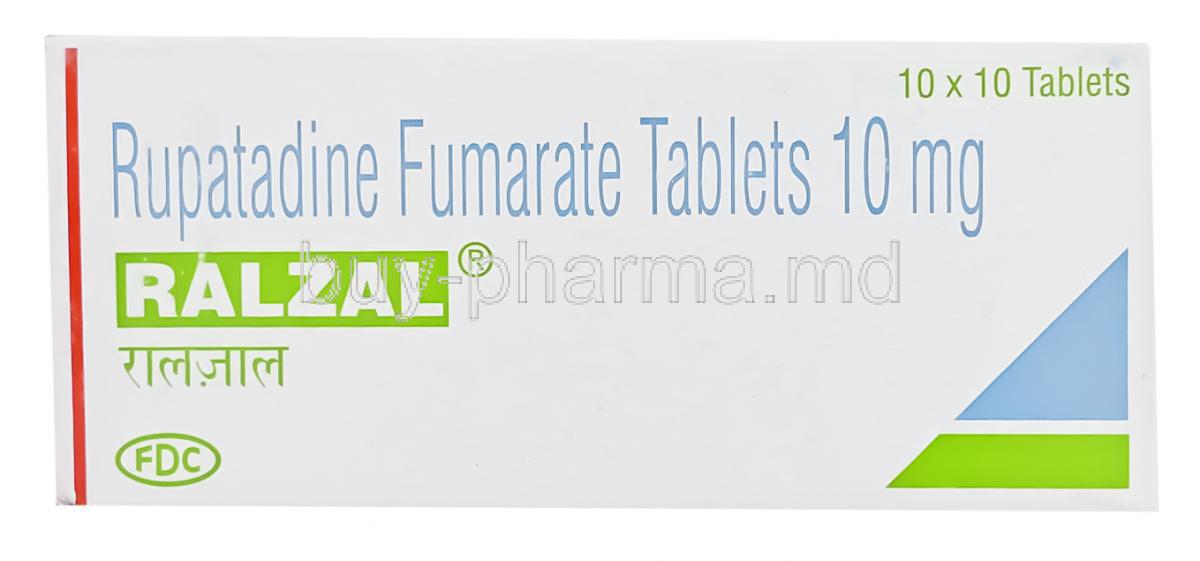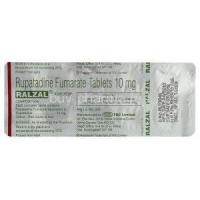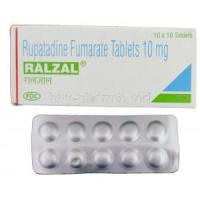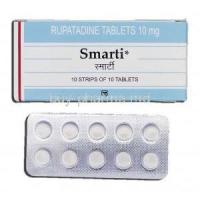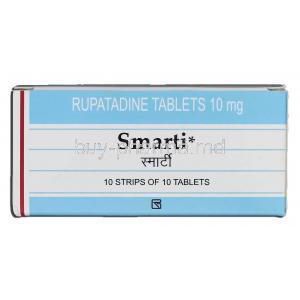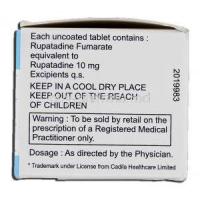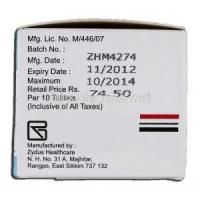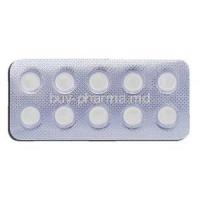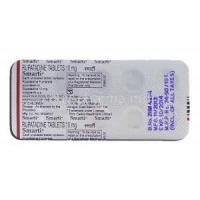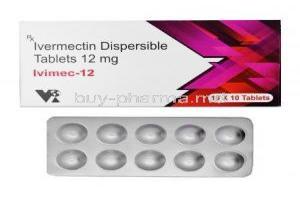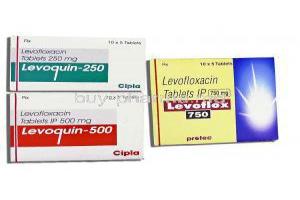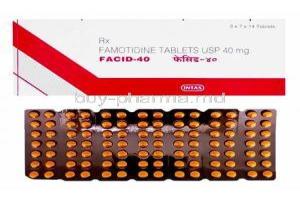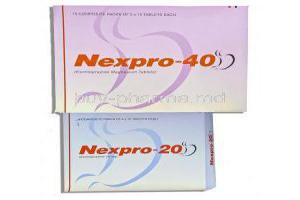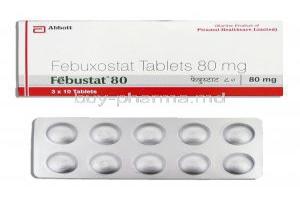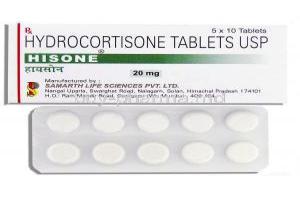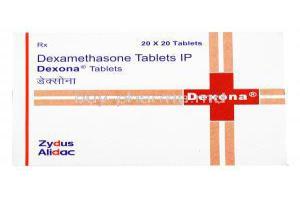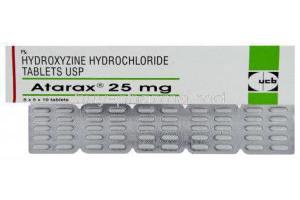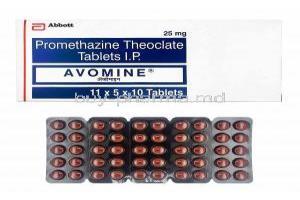Rupatadine
I. Introduction
Rupatadine is a complex medication that falls under the category of second-generation antihistamines. It serves a role in managing allergic disorders by combining antihistaminic and antiplatelet activating factor (PAF) abilities.
This dual action provides relief for conditions like urticaria and allergic rhinitis by targeting specific histamine receptors to counteract the effects of histamine release, which is a major contributor to allergic responses.
Historical Background
The origins of Rupatadine can be traced back to the 20th century when researchers were exploring antihistamines. Significant milestones include discovering its antagonistic action on both histamine H1 receptor and platelet-activating factor conducting thorough preclinical studies that paved the way for human trials, and obtaining regulatory approval for market launch in various countries in the early 21st century.
Therapeutic Class and Mode of Action
These achievements highlight how scientific innovation and regulatory considerations have influenced Rupatadine's journey in the field. Rupatadine belongs to the class of antihistamines, which are known for their ability to counteract effects on the body.
Rupatadine works in a way to treat allergic reactions. It does this by blocking the H1 receptor, which prevents histamine from binding and reduces inflammation and allergic responses. Additionally, it inhibits the action of platelet-activating factor (PAF) which is involved in blood vessel permeability and bronchoconstriction.
This dual approach makes Rupatadine unique among antihistamines making it a valuable and versatile treatment option for allergies.
Uses of Rupatadine
Rupatadine has been approved for medical purposes in numerous countries due to its proven effectiveness and safety. Its pharmacological foundation allows it to be used in the treatment of conditions such as ;
- Allergic Rhinitis(1)
- Chronic Urticaria.
Treatment of Allergic Rhinitis
When it comes to treating Allergic Rhinitis, which's a common and debilitating condition, Rupatadine has shown positive results. This condition involves immune reactions that lead to symptoms like nasal congestion, sneezing, and itching.
By blocking histamine H1 receptors, Rupatadine helps alleviate these symptoms. Patients who undergo this treatment report a quality of life with noticeable reductions in both the severity and duration of their symptoms.
Treatment of Chronic Urticaria
For Chronic Urticaria management, which is characterized by recurring hives, a comprehensive therapeutic approach is necessary. Rupatadines' dual action on receptors and platelet-activating factor (PAF) provides a multi-faceted strategy;(2)
- it suppresses localized inflammation and reduces itching and hives appearance while also improving overall skin condition and patient well-being.
This innovative approach positions Rupatadine as a component in managing chronic urticaria.
Off Label uses
Apart from its approved uses, Rupatadine has also found off-label applications beyond its indicated purposes.
The expansion of its scope is both interesting and intricate, involving the exploration of new treatments.
- Research is currently underway to investigate the use of Rupatadine in treating atopic dermatitis and other allergic disorders.
- Initial findings suggest that Rupatadine may have a role in addressing various allergic conditions.
Ethical considerations and regulatory challenges come into play when it comes to off-label administration. Physicians must carefully consider the evidence supporting off-label use while being mindful of risks. They need to base their decisions on the available scientific evidence and ethical principles.
The diverse range of applications for Rupatadine, from its uses to exploring new possibilities, highlights its dynamic nature in modern medicine. Whether used within approved guidelines or in off-label contexts, Rupatadine's therapeutic impact continues to expand, establishing it as an asset in managing allergic disorders.
1. WileyOnlineLibrary - Rupatadine in allergic rhinitis and chronic urticaria
2. NCBI - Rupatadine: pharmacological profile and its use in the treatment of allergic rhinitis
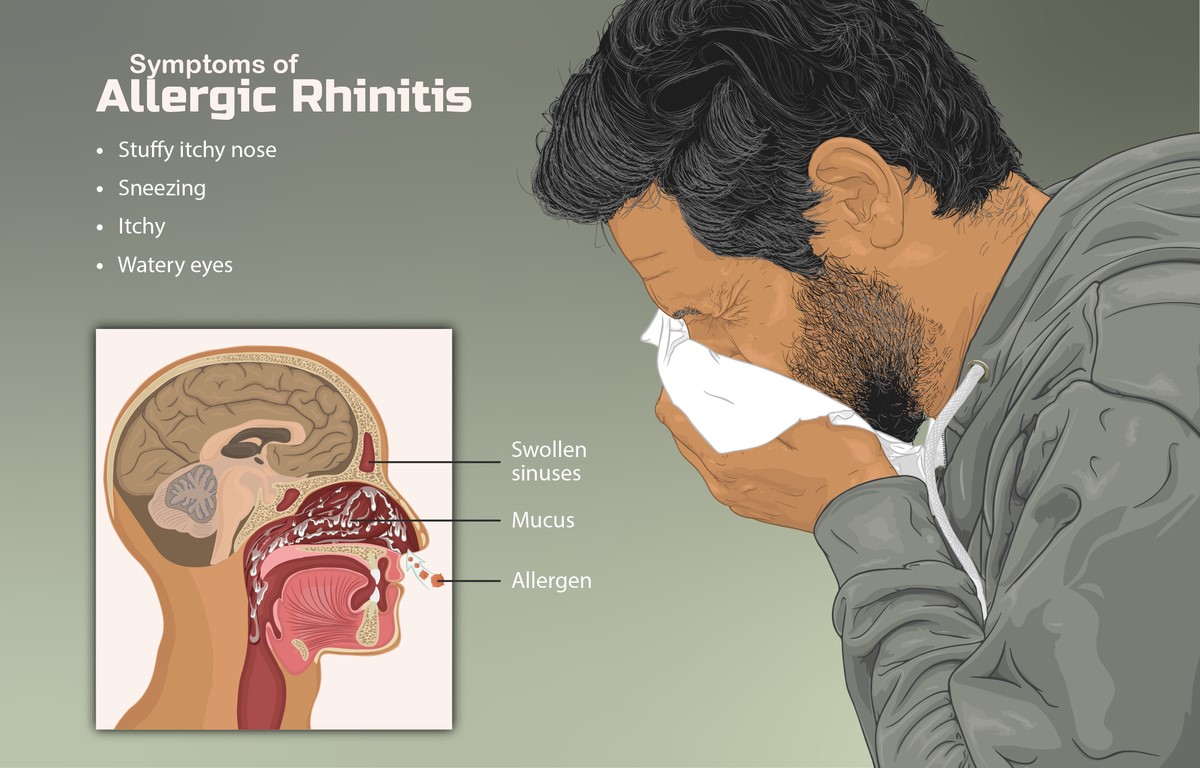
Allergic Rhinitis Symptoms
Symptoms of Allergic Rhinitis
III. Composition
Chemical Structure
A molecular structure characterizes Rupatadines' chemical composition. It combines piperidine units resulting in the molecular formula C26H26ClN3O and a molar mass of 429.96 g/mol.
Notable features of Rupatadine include its ability to pass through cell membranes due to its lipophilicity easily, its stability at normal temperatures, and its limited solubility and bioavailability due to its hydrophobic nature.
Pharmacological classification
In terms of classification, Rupatadine falls under the category of second-generation antihistamines. It acts as a histamine H1 receptor antagonist, relieving histamine-induced symptoms while inhibiting platelet activating factors (PAF).
Inactive ingredients
Furthermore, the formulation of Rupatadine includes ingredients that contribute to its stability, appearance, and taste. These ingredients include lactose monohydrate, microcrystalline cellulose, magnesium stearate well, and various coloring agents.
IV. How it Works
How Rupatadine Works;
Rupatadine works by blocking histamine H1 receptors and platelet-activating factors, which helps prevent allergic responses. Additionally, it inhibits platelet-activating factor (PAF) a substance that contributes to inflammation and increased permeability of blood vessels.
Pharmacodynamics and Pharmacokinetics of Rupatadine;
Rupatadine is quickly absorbed and distributed throughout the body's tissues when taken orally. It is then widely distributed, and It primarily undergoes metabolism in the liver. It is mainly eliminated through the kidneys and renal pathways
Clinical Effectiveness in Allergic Conditions;
Rupatadine has proven to be effective in treating different allergic conditions. It has shown relief of symptoms and improved outcomes for patients with chronic urticaria (hives) and allergic rhinitis (hay fever), in various clinical trials.
V. Dosage and Administration
Guidelines
When administering Rupatadine, it is important to follow guidelines that take into account factors like the patient's age, weight, and underlying health conditions. Typically adults are prescribed a dosage of around 10 mg.
Specific Dosage for Various Conditions
The dosage may vary depending on the severity and type of condition being treated. For example, Allergic rhinitis usually requires dosing. Chronic urticaria may need adjustment based on symptoms.
Dosage for Special Populations
Special populations such as patients, pregnant individuals, or those with liver or kidney problems may require specific dosage considerations. It is crucial to adjust the dosage to ensure both safety and effectiveness.
Administration Techniques
Rupatadine is commonly taken orally in tablet form. It is important to follow the prescribed guidelines and swallow the tablet whole without crushing or chewing. By following these administration techniques, you can ensure that you receive the maximum therapeutic benefit from Rupatadine.
VI. Administration to Special Populations
Elderly Patients
When prescribing Rupatadine to patients, it is important to carefully consider their kidney function and overall health status. In some cases, a lower initial dosage may be necessary to minimize risks, and close monitoring is recommended.
Pregnant Women and Nursing Mothers
For women and nursing mothers, the use of Rupatadine requires a thorough evaluation of the possible risks and benefits. While data on the safety of the drug in this group are limited, it should only be used during pregnancy if necessary and under medical supervision. Nursing mothers should also explore alternative treatment options due to the effects on breastfed infants.

Pregnant woman
Pediatric Administration
When administering Rupatadine to patients, appropriate dosing adjustments based on their weight should be made, along with close monitoring for any specific side effects related to children.
Dosage Adjustments
It is crucial to review their history thoroughly and make regular dosage adjustments as needed. Collaboration with healthcare professionals is also important for comprehensive care in these cases.
VII. Side Effects
Common Side Effects
Some common side effects of Rupatadine may include
- drowsiness
- fatigue
- headaches
- dry mouth

Fatigue
Mild to Moderate Reactions
Mild to reactions usually resolve on their own and may include nausea and stomach discomfort. These symptoms typically do not require any treatment.
Frequency and Duration
Most side effects are temporary. Tend to become less frequent as you continue the therapy. However, if your symptoms persist or worsen in severity, it is important to consult a healthcare professional for evaluation.
Serious and Rare Side Effects
Although serious side effects are rare, they can occur. In some cases, Rupatadine may cause anaphylaxis or other hypersensitivity reactions. If you experience any allergic reactions or immediate medical emergencies, seek immediate medical attention.
Risk Factors and Management
Certain risk factors such, as existing conditions or medications may increase the likelihood of experiencing side effects. It is important to monitor your condition while taking Rupatadine. Your doctor may consider adjusting the dosage or discontinuing the medication if necessary. Additionally, it is crucial to be aware of adverse reactions and promptly report them to your healthcare provider.
Long-term Effects and Monitoring
In general, Rupatadine does not have long-term effects. However, regular monitoring is still recommended as a measure to detect any unforeseen complications that might arise during ongoing therapy.
VIII. Interactions
Drug-Drug Interactions
When taking Rupatadine it's important to be aware of interactions with other medications, particularly those that affect liver enzymes. If you're using medications alongside Rupatadine your healthcare professional may need to monitor you closely or make adjustments to your dosage.
Food and Healthcare Interactions
It's also worth noting that certain foods or alcohol could impact the effectiveness of Rupatadine or worsen any side effects. Following the guidelines provided by your healthcare professional is crucial in ensuring its optimal effects.
Monitoring and Management of Interactions
To effectively monitor and manage these interactions it's recommended to review your medication lists receive counseling on possible interaction risks from your healthcare provider and coordinate, with other healthcare professionals involved in your care.
IX. Warnings and Contraindications
Warnings and Precautions
It is important to use Rupatadine with caution if you have any liver or kidney problems or if you are known to have hypersensitivity to the drug or its components.
Contraindications
Rupatadine should not be used if you have experienced reactions to it in the past. Additionally, there may be health conditions that need careful consideration before using this medication.
Careful Administration Considerations
When administering Rupatadine, it is essential to take an approach. This involves assessing the patient's history and potential contraindications regularly monitoring for effectiveness and possible adverse reactions as well as providing educational support to ensure patient compliance and awareness.
X. Overdosage
Symptoms and Signs
In cases of taking much Rupatadine, there can be a range of symptoms from worsening common side effects to more severe neurological symptoms. These may include increased drowsiness or fatigue, irregular heartbeats, and difficulty breathing.
Management and Treatment
When dealing with an overdose of Rupatadine, effective management requires a combination of medical interventions, Immediate medical evaluation, and providing necessary support. If the ingestion happened recently, activated charcoal may be used. Monitoring signs closely and providing symptomatic treatment as needed.
Prevention Strategies
Preventing overdosage involves approaches; Educating patients and caregivers about the correct dosage and implementing safety measures such as packaging that is child resistant. Regular monitoring to ensure patients understand and comply with instructions.
XI. Storage and Handling Precautions
Storage Requirements and Conditions
To ensure the effectiveness and stability of Rupatadine, it is important to store it. Keep it at room temperature away from heat and moisture in its original container to protect it from light.
Packing and Dispensing
When packaging and dispensing Rupatadine, attention to detail is crucial; use child containers and provide clear labeling with instructions and warnings. It is also important to maintain the integrity of the packaging during transportation and storage.
Safety Considerations in Handling Disposal
The safety of healthcare personnel and patients is important when handling and disposing of Rupatadine. Follow pharmaceutical handling guidelines and dispose of it properly according to local regulations to minimize any environmental impact.
XII. Important Precautions
Monitoring and Follow up
Continuously monitoring and following up with patients is essential when it comes to Rupatadine therapy. This involves assessing patients to determine their effectiveness and identify any adverse reactions. It's also important to coordinate with healthcare providers for a comprehensive treatment approach.
Patient Counseling and Education
Patient counseling and education play a role in optimizing the outcomes of therapy. This includes providing information about side effects and how to manage them effectively. It's also important to address any misconceptions and encourage patients to adhere to their therapy regimens.
Risk Mitigation Strategies
To minimize the risks associated with Rupatadine, a systematic approach is necessary. This involves identifying any risk factors in individual patients and implementing precautionary measures such as adjusting dosage or increasing monitoring. Educating and communicating with patients is vital to ensure they fully understand and comply with the guidelines for their therapy.
XIII. Overview
Key Points Summary
Rupatadine is a medication that has multiple uses and important factors to consider. These include its effects on the body how it should be taken, interactions with other medications, and crucial safety precautions.
Implications for Clinical Practice and Future Directions
The use of Rupatadine in practice is continuously evolving, with ongoing research uncovering its potential in new areas of treatment. It is essential for researchers, healthcare professionals, and pharmaceutical experts to collaborate to further refine its role, in medical practice.

